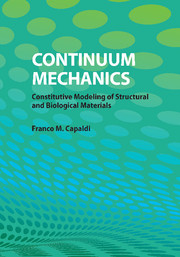4 - Introduction to Material Modeling
Published online by Cambridge University Press: 05 August 2012
Summary
As engineers, we seek to develop mathematical models that allow us to predict a system's response to external stimuli. For example, one might want to predict the strain that results when an object is subjected to a set of prescribed forces. In this text, we will discuss the development of a set of equations that describe the relationship between applied forces, thermodynamic variables, and deformation. The procedure presented for building a practical model of a material system consists of four major steps. First, we must identify the forces, fields, and thermodynamic variables that we would like to model. For example, we might be interested in modeling the material's response to changes in temperature and electric field. In nature, there are many forces and fields which influence the behavior of materials. A model that captures the coupling between all of these fields would be exceedingly complex. Instead, we must select the forces and field which are of primary interest or restrict the applicability of the mathematical model to a narrow range of external forces to simplify the model. Second, the balance laws and constitutive model must be formulated given the relevant variables and material characteristics determined in step one. The result of this second step is a set of mathematical equations describing the connections between the selected forces and fields in the given material system. Third, a strategy for parameterizing the constitutive model must be developed.
- Type
- Chapter
- Information
- Continuum MechanicsConstitutive Modeling of Structural and Biological Materials, pp. 85 - 121Publisher: Cambridge University PressPrint publication year: 2012



